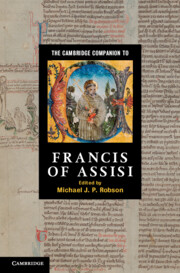Book contents
- Frontmatter
- Introduction
- PART I Francis of Assisi
- PART II The heritage of Francis of Assisi
- 10 Francis and the pursuit of learning
- 11 The early Franciscans and the towns and cities
- 12 The Third Order of Francis
- 13 Franciscan ideals and the royal family of France (1226–1328)
- 14 Franciscans as papal and royal envoys to the Tartars (1245–1255)
- 15 Franciscan missions
- 16 Pope John XXII, the Franciscan order and its Rule
- 17 The ecumenical appeal of Francis
- A guide to further reading
- Index
10 - Francis and the pursuit of learning
from PART II - The heritage of Francis of Assisi
Published online by Cambridge University Press: 28 November 2011
- Frontmatter
- Introduction
- PART I Francis of Assisi
- PART II The heritage of Francis of Assisi
- 10 Francis and the pursuit of learning
- 11 The early Franciscans and the towns and cities
- 12 The Third Order of Francis
- 13 Franciscan ideals and the royal family of France (1226–1328)
- 14 Franciscans as papal and royal envoys to the Tartars (1245–1255)
- 15 Franciscan missions
- 16 Pope John XXII, the Franciscan order and its Rule
- 17 The ecumenical appeal of Francis
- A guide to further reading
- Index
Summary
INTRODUCTION
The stunning transformation of the Franciscan order from a small band of laymen into a well-organised international order of educated preachers and theologians, with schools all over Europe, took place even more quickly than was acknowledged until recently. Ignoring suggestive insights by Hilarin Felder, who in 1904 published the first monograph on this issue, many historians writing on Franciscan education have argued that the question of studies was only addressed systematically under Bonaventure, minister general (1257–73), and particularly by the constitutions of Narbonne in 1260. According to this interpretation, the creation of a school network began in earnest under the Franciscan ministers general Albert of Pisa (1239–40) and Haymo of Faversham (1240–4), to be brought to full fruition under Bonaventure.
As numerous Franciscan study houses can be traced back to the early 1220s, and Franciscan chronicles provide references to lectors and the exchange of students during the 1230s, it becomes plausible to assume that the creation of schools and provincial study houses for the training of lectors was well under way during the leadership of Elias, who governed the Franciscan order as a vicar from 1221 to 1226, and again as minister general between 1232 and 1239. This brings the problem of studies back to Francis's final years. Between his abdication of leadership of the order in 1221 and his death in 1226, Franciscan schools and study houses started to appear in Italy, Spain, France and England.
- Type
- Chapter
- Information
- The Cambridge Companion to Francis of Assisi , pp. 159 - 177Publisher: Cambridge University PressPrint publication year: 2011

